Patrick Mahomes' film review, Week 1: game manager extraordinaire
Mahomes won within the system Thursday, and did extra when it was needed
There’s a lot that goes into playing quarterback in the NFL. Basically every statistic that we use to quantify quarterback production (yards, touchdowns, completions, interceptions, and all the more “in-depth” stats that track some combination of those things on a per-play basis) fails to contextualize what matters and what doesn’t at the position, and instead looks at the RESULT of a play.
Of course, the result might have very little to do with quarterback play. As I wrote about in detail for The Athletic, utilizing stats to gauge a QB’s play means you might end up valuing a screen pass over a 15-yard out from the opposite hash, or blaming a QB for failures by other members of the team.
For example, utilizing stats this is a “bad” play by Patrick Mahomes.
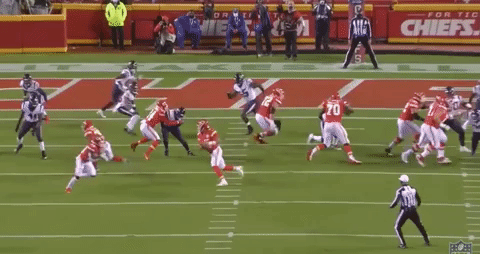
Here, Mahomes is rolling out by design with 3 options. He quickly scans through the first 2 and finds them covered, then sees Robinson open moving across the back of the end zone. With pressure closing he has to throw from an absurd angle to get the ball out, and has to be sure to bend the angle around the incoming defender. He does so and still manages to get zip on the ball and puts it in a very catchable place for his receiver away from any possible contesting by the defender.
It’s a fantastic play, but it gets dropped. The idea behind using statistics to gauge QB play is that after enough snaps this sort of thing will “even out” for every QB, but in a game of small sample sizes that’s not really true, at least not during individual games (maybe 30 to 50 throws) or even a full season (between 500 to 600 throws, generally). So utilizing statistics to gauge a single game or even a full season doesn’t tell us what matters.
If you haven’t subscribed yet, I have no idea what you’re waiting for. For $12/year forever, or $2 a month if you want to give it a quick try, you’ll have access to multiple film reviews and other commentary every week. That’s what you pay for a decent meal at McDonald’s for a full year, and I’ll never raise the price on you. Free subs give you an article every few weeks, but I promise you we’re doing MUCH more than that here. Click below to subscribe, and let’s get crazy.
What really matters when gauging quarterback play is as follows: Pocket presence, accuracy, vision/awareness (the ability to see the field and go through reads), playmaking ability when things break down, protecting the ball and avoiding mistakes. There’s more, but these are the fundamental things that will separate good and bad quarterbacks.
So for years, I’ve charted every dropback by Chiefs quarterbacks tracking the following: plays/yards created, franchise throws, multiple-read plays, accuracy in and out of the pocket, “flushes” (pressure by the OL before any viable options came open), drops/yards lost, potential INTs, missed shots, happy feet snaps (when the quarterback bails on a clean pocket or moves in a way that makes his blockers’ jobs harder), and the depth of target. The goal is to know as much as possible about how the QB actually performed in a game.
With that primer, let’s talk Mahomes vs the Texans, which was a fascinating game for him. The Texans played an extremely cautious gameplan against the Chiefs, playing a lot of zone with a pair of safeties deep and defenders clearly trying to keep everything in front of them. In years past, Mahomes might have pressed trying to make something happen deep, but instead he simply took what the defense gave him to play an efficient game with few mistakes and a few spectacular plays when needed. It wasn’t his best game, or close, but it was a unique one in that he relied much more on his brain than his arm.

(note that not every throw can be charted for accuracy given throwaways and miscommunications with receivers, and occasionally depth of target is tough to tell as well. So the numbers may look wonky at times)
Mahomes played a smart, efficient game against the Texans in which he relied on his ability to read the defense pre and post snap to win.
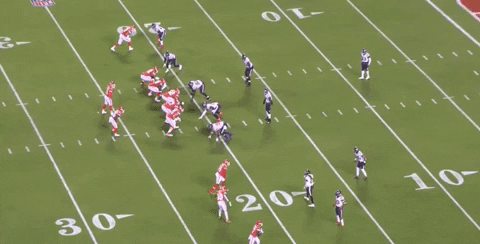
The Chiefs utilize a shift from Hill prior to the snap to determine what sort of coverage the Texans are in (in this case, apparent man coverage) and to identify which defender is looking to defend Watkins. Once that’s done, Mahomes reads the linebacker while running a run/pass option to Clyde Edwards-Helaire. He knows where Watkins route is going and he knows given the leverage he’ll have separation from the cornerback. The question is whether the linebacker will cut off the throwing lane.
The moment Mahomes sees the linebacker shift to his right, he knows that Watkins will be open if the ball is placed correctly, and the Chiefs gain an easy 11 yards.
Mahomes’ day was filled with mental wins like this one, in which he knew where he was going with the ball before the snap based on what the coverage gave him.
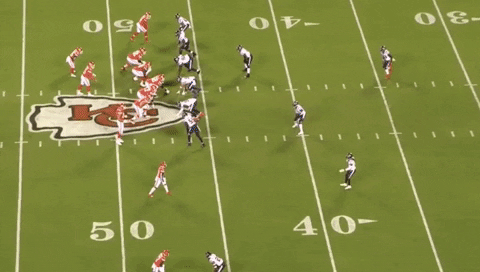
Once again, the Chiefs used presnap motion to diagnose whether the Texans’ are playing man or zone. Once Mahomes' sees that they’re playing zone, he trusts Kelce to make a sight adjustment on his route to sit down for the ball in an empty spot. It’s easy, no-risk yardage.
Mahomes got rid of the ball at an average of 2.35 seconds according to Next Gen Stats, one of the fastest times of any quarterback in Week 1. This is almost a full half-second faster than the 2.82 he averaged in 2019. While that may seem like an insignificant difference, it’s a chasm when it comes to quarterback release time.
This faster release made it difficult for the Texans to pressure him, and showed yet another step forward in Mahomes’ ability to read the field. Go watch a few games of Peyton Manning sometime. You’ll see throw after throw to his first read. That’s because no one read defenses presnap like Manning, and he almost always knew where the weakness in the coverage would be. Mahomes (I assume) isn’t at that level as of now, but he was markedly quicker with his decisions in Week 1 than he has been previously, and those decisions were almost always correct regardless of what the Texans tried.
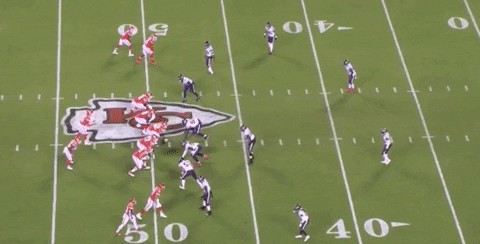
The Texans get quick pressure here by utilizing a slot blitz. This exact look has given Mahomes some issues presnap in the past due to not recognizing that it’s coming. While he’s been able to defeat free runners utilizing his uncanny ability to escape, it’s been a coin flip.
This time, he sees the blitz coming and immediately gets the ball out to the the area of the field where the blitz has given up a numerical advantage. Once again, he won with his mind rather than his arm/legs.
Mahomes was choosing the easy throws at the right moments on Thursday, even if it looked like a missed shot when he did so.

On the first 3rd down of the game (3rd and 4), Hill ends up with man coverage and a single-high safety over the top. It’s one of the few opportunities Mahomes had to push the ball down the field, as Hill (predictably) wins quickly and a good throw would put the ball in place before the safety could arrive to help, despite him being slightly shaded to Hill’s side of the field.
Mahomes doesn’t look that way, though. It should be noted that a throw to Hill would’ve caused the safety to move very differently, closing fast (the speed that NFL defenders close on throws is truly unbelievable, we’ll talk about that more in a bit regarding Robinson’s end zone drop on the first drive), but he never even gets to that read. Instead, he sees that Kelce’s route has slowed down the defender in man coverage on Williams out of the backfield, and hits him for an easy first down.
That sort of “game manager” play might not be popular all the time, but it’s the correct throw on 3rd down. Deep shots are inherently risky and less likely to succeed, and by taking the throw that is almost certain to give the Chiefs a fresh set of downs Mahomes gives the offense another 3 chances to attack the defense.
Plays like this are demonstrative of Mahomes’ growth as a passer. In previous years a well-executed defensive plan to take away the deep and intermediate portions of the field might have frustrated him and led to some forced throws. In Week 1 he carved it up.
He threw with unbelievable anticipation most of the night as well. His first touchdown to Kelce he started the throw when Kelce was still surrounded by 3 defenders, knowing where the play WOULD be in a moment rather than judging where it was. And when he needed to make those same sort of throws and create yardage under pressure, Mahomes flipped the switch from game manager to “Mahomes.”
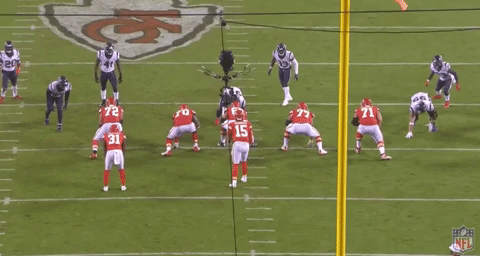
This throw is exponentially more difficult than the basic stats make it appear. The Texans dial up a little pressure on a nice stunt and blitz from the edge (design to win the corner with a faster player, knowing Mahomes takes deep drops on 3rd down) after disguising their coverage before the snap. They also double Hill and (though you can’t see it from this angle, as we’re looking more at the throw here) have good coverage across the board.
So they’ve got disguised coverage and quick pressure from both the interior and the edge, as well as a double team on one of Mahomes’ favorite targets. And none of it matters because Mahomes sees what’s happening and makes a throw across the grain of his body, lofted into the air so Hill has time to run underneath it, and placed away from the defenders.
Being able to unlock “that” mode on 3rd downs allows Mahomes to be a game manager of the very best sort. He’s able to take the free yardage throughout the game, and on 3rd down or other situations where the Chiefs need him to create yards or make a great throw he can do so.

This touchdown somehow got overlooked at the time, perhaps an example that we’re becoming used to what Mahomes does. With pressure coming from the interior on a well-executed delayed blitz that gave the Texans numbers, Mahomes is forced right. The Texans anticipated this (they really did do everything “right” on a lot of snaps) and had another blitzer looping that way to close.
With multiple defenders screaming towards him, Mahomes continues to drop back and throws one of his patented fadeaway lasers to Hill in the back of the end zone. This ball needed to have zip and good placement to get home, and it should be noted that putting it farther towards the sideline risked interference by the receiver/defender combo underneath. It is, in a word, absurd.
Mahomes could have had stats that would have led to a “louder” game. He completed 75% of his passes and threw for 3 touchdowns, but at a low (especially for him) 6.6 yards per attempt. That would have changed considerably had Robinson hung on to an early deep ball, which is an example why stats betray us.
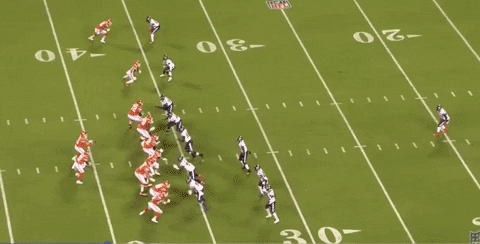
Robinson has an obvious chance to pull in this deep ball and gets outmuscled by the cornerback. There was some criticism that Mahomes should’ve put the ball another yard or 2 in front of him. While it’s true that at that point we’re getting a little absurd, but even if that would have made the catch easier in a vacuum, football isn’t played without other defenders lurking.
Remember when I mentioned how quickly NFL defenders close? Watch the safety here. Though he follows Hill initially, he sees the ball come out and sprints back towards Robinson. If that throw is another 2 yards in front, unless Mahomes puts it on an absolute rope (which makes accuracy even more tough) Robinson is going to get decapitated. Reasonable minds can differ on such things, but in my opinion putting the ball where he did gave the receiver the best shot at making the catch.
Had Robinson done so, we’d be altering Mahomes’ stat line to 25/32 for 247 yards and 4 touchdowns, and his YPA would be raised to a much more Mahomes-like 7.7. Again, this is demonstrative of why in a small sample game with lots of variables it’s foolish to trust statistical output to gauge a quarterback.
Mahomes was not perfect against the Texans. He had several inaccurate throws that were ugly, largely due to not setting up prior to releasing. He also threw a pair of potential picks, though one came on 4th down where he didn’t have any other options and he was just giving the play some chance at success (the overturned interception in the end zone). I don’t fault him for that, but the other was either a badly missed throw down the right sideline or a miscommunication.
Mahomes also had one of the worst missed shots I’ve seen him collect, though it didn’t end up hurting the Chiefs as they scored the next play.
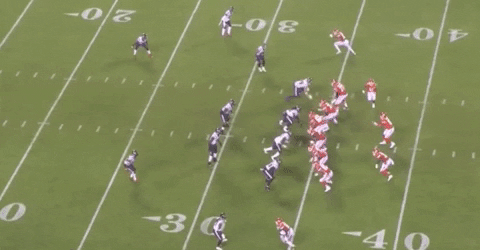
Here, Mahomes has Kelce going deep down the left sideline. The defense gets sucked up the field and flat-out misses his route seemingly, and Mahomes doesn’t see him. Sometimes a quarterback has already advanced in his reads and there’s not much to be done, but he was looking at that area of the field here and should have seen what the coverage was doing relative to Kelce’s route. He took the checkdown to Robinson, but left a big play on the table on 1st down in a game where those opportunities were sparse.
Mahomes also made a hasty decision late in the game, while also hanging Edwards-Helaire out to dry a bit on a throw.
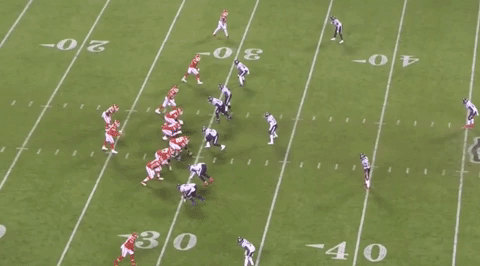
On this 3rd and 6, Mahomes has plenty of time to sit and survey the field but instead elects to get rid of the ball immediately to a covered CEH (very likely the first read, similar to Williams’ 3rd and 4 conversion earlier). The linebacker makes an admittedly nice play by not getting picked by Hill’s route (which is what the design of the play), but Mahomes could have seen that and elected to progress in his reads.
The game was well-decided at this point, and there’s every chance Mahomes just wanted to get the ball out and prevent even the slightest chance of a bad play that could give Houston a puncher’s chance at coming back. But I’d still like to see him give the play a chance to develop here.
Overall, Mahomes played a game almost void of mistakes on a day the Texans overall executed their gameplan well. He took what was given to him and didn’t force things, then made plays happen when it was necessary.
Today’s game features a Chargers defense that has played Mahomes as tough as anyone consistently has over the last 2 seasons. It will be interesting to see if Mahomes’ seemingly sped-up mental processing helps him perform better than he has against them previously (not that he’s ever been “bad” against them, just less than his usual). If it does, that would serve as confirmation that Mahomes has taken yet another step forward.



I am happy to see this film review. Andy is going to screen the Chargers into oblivion and slow Bosa and Ingram down. I see a lot of runs by Clyde, and Watkins and Kelce will eat in the holes in zones. Tyreek and Hardin will open them up. I really want to see Clyde in space and yes, get those 377 yards or at least his first 300 yard game against this team. Chiefs 38 Chargers 17.
Seth, you hit the bullseye emphasizing Mahomes improved pre-snap processing. It also explains the greater number of runs against Houston’s defense. Mahomes isn’t to Manning’s processing, but this development scares defensive coordinators. Nice article!